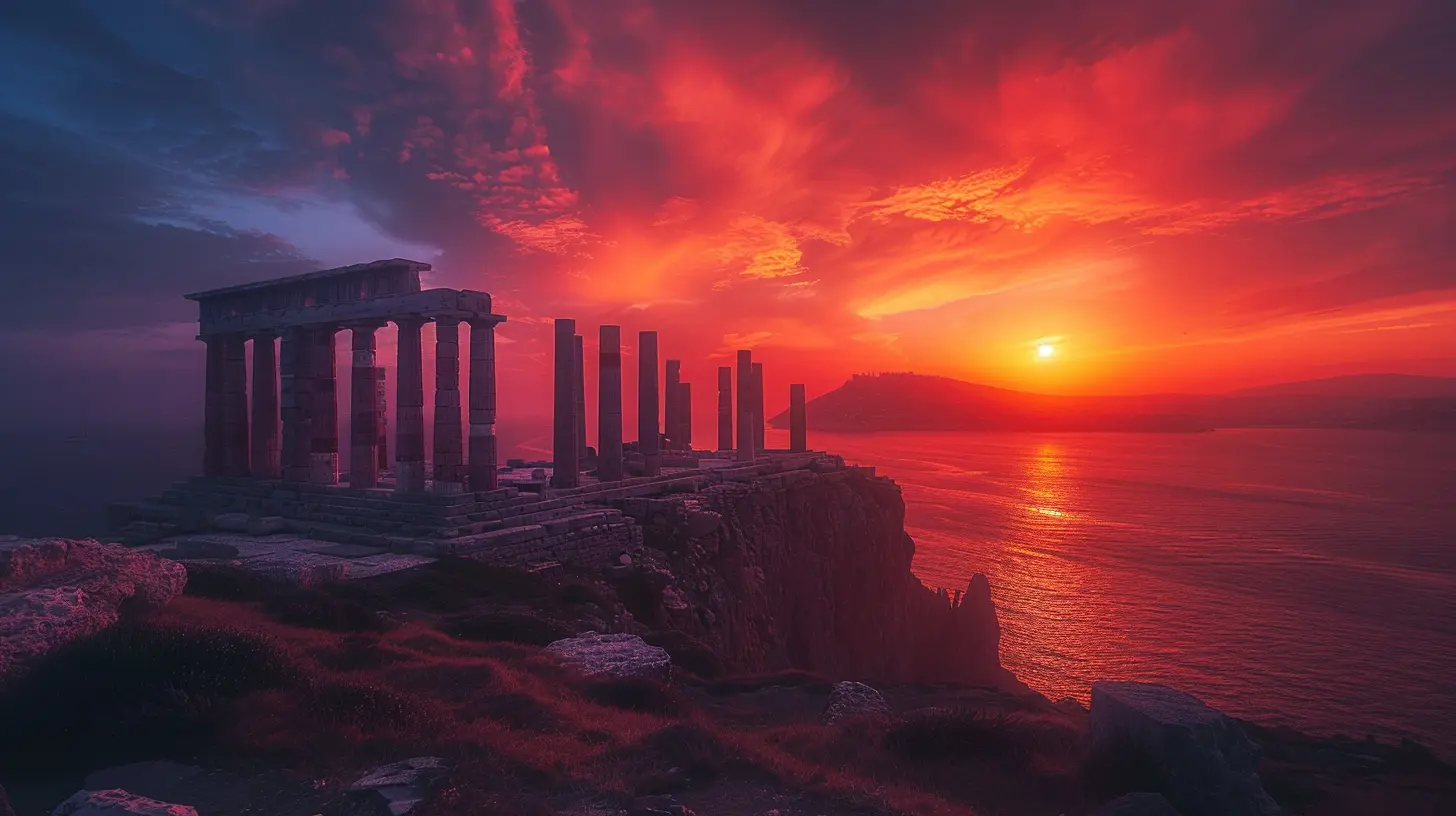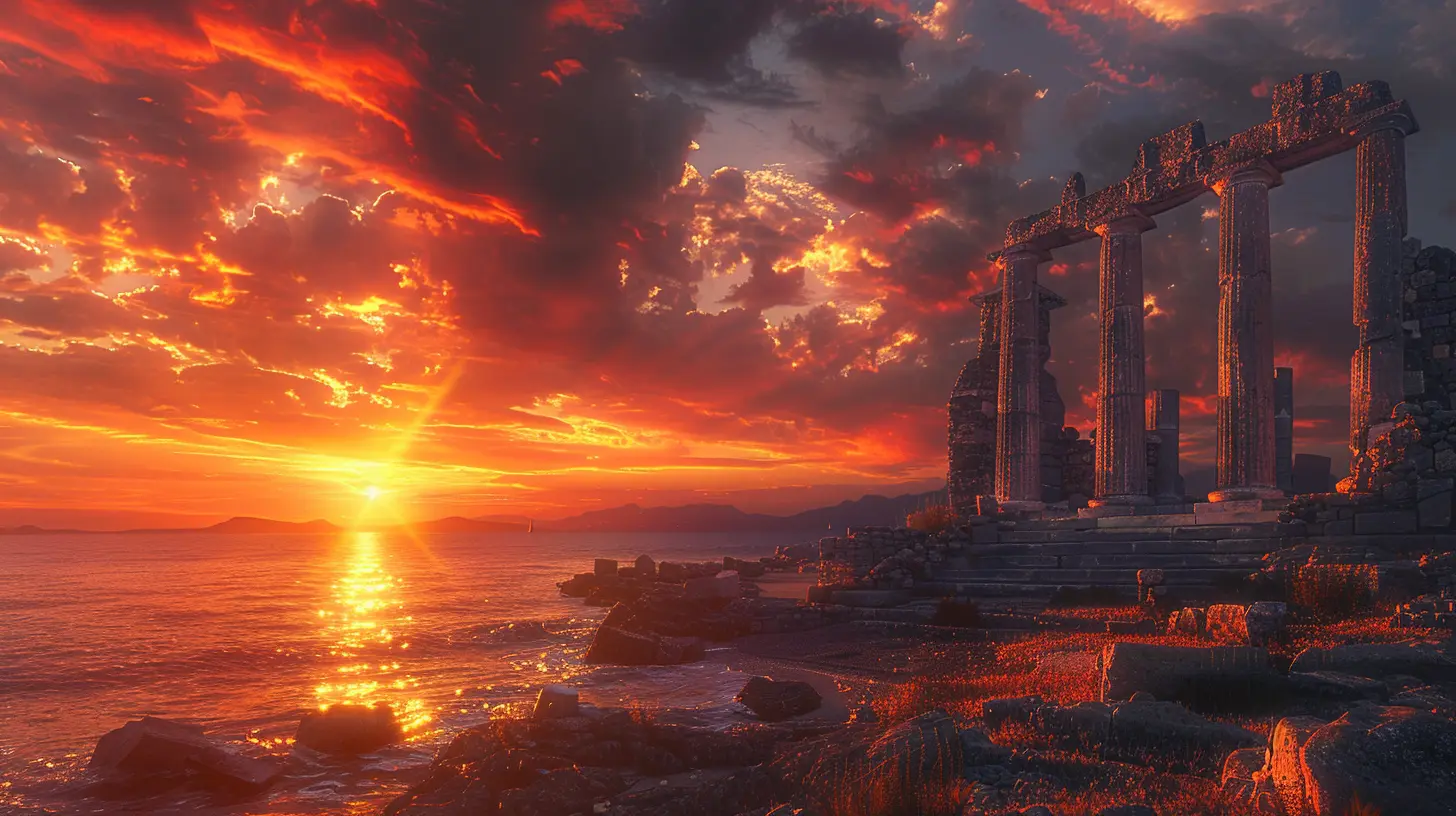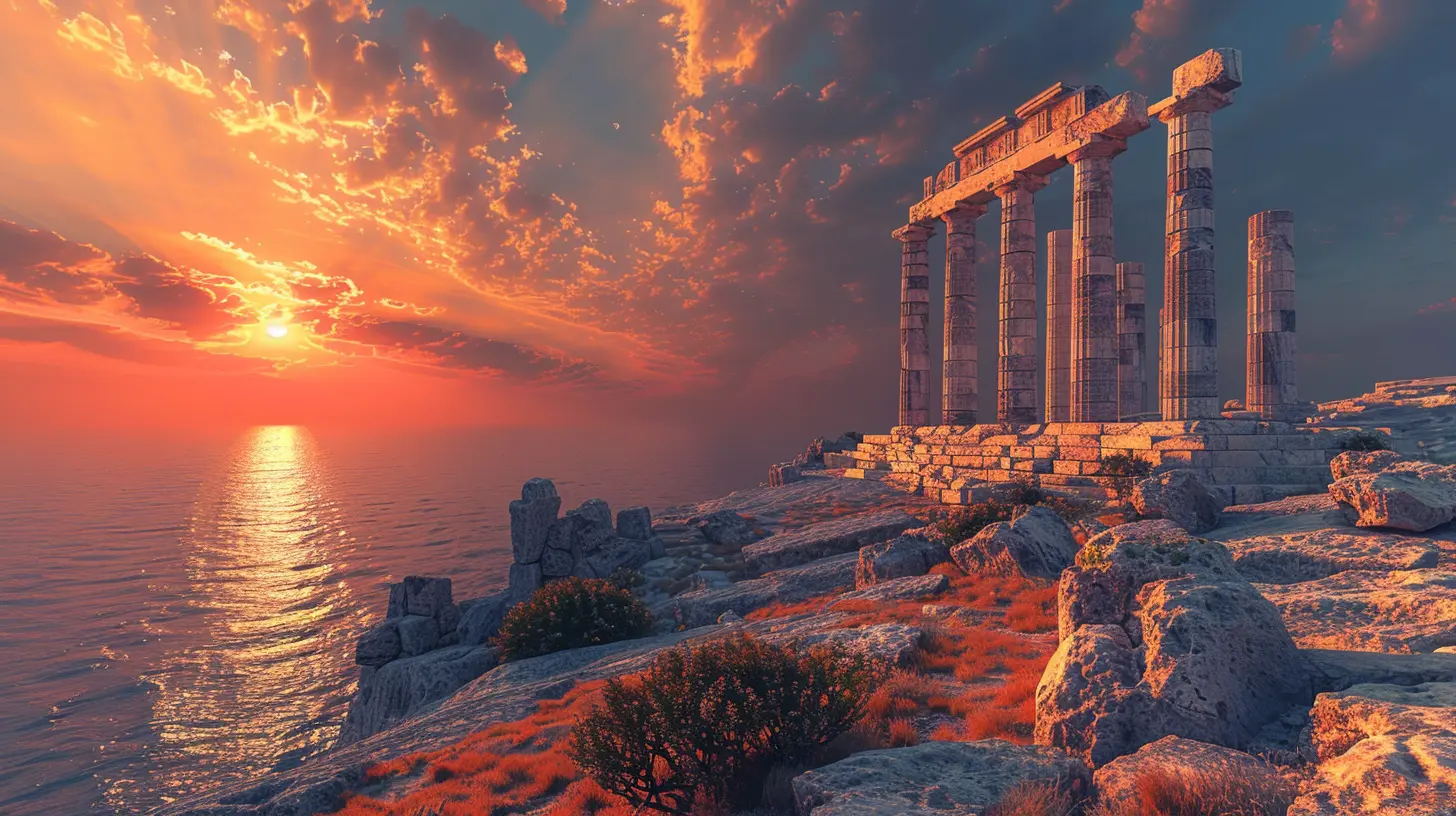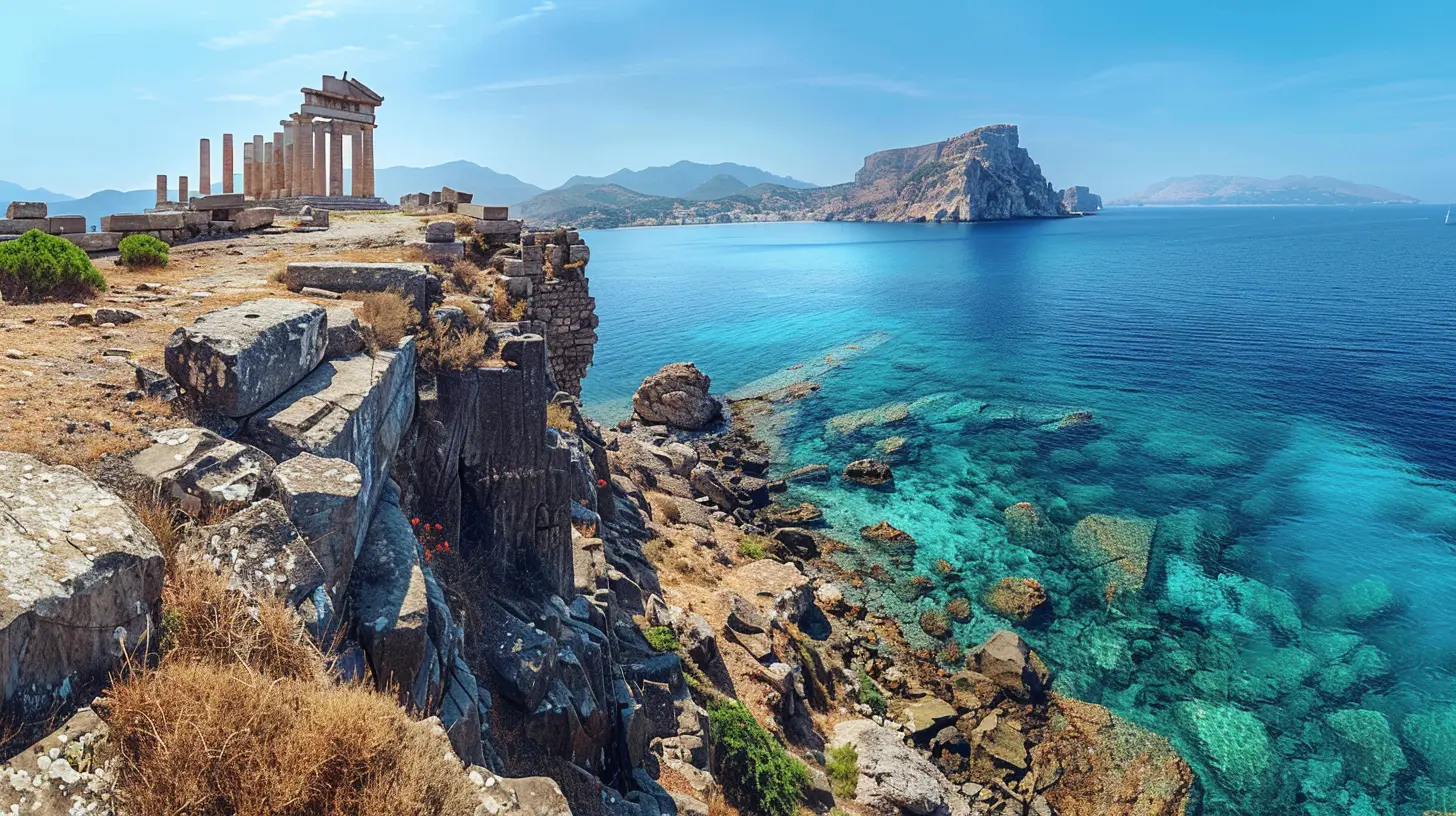The Intriguing Silence of the Temple of Poseidon
25 December 2024
Have you ever stood in a place so quiet that it feels like time has stood still? That’s the sensation you might get when you visit the Temple of Poseidon, perched high above the shimmering Aegean Sea at Cape Sounion, Greece. It’s a place where history whispers through the stones, and the silence is, in a way, louder than the crashing waves below.
In this article, we’ll unravel the compelling silence that envelops this ancient sanctuary—a powerful kind of silence that seems to reach out, tugging at your soul, offering both peace and mystery. So, let’s dive deep into the fascinating world of the Temple of Poseidon.

A Brief Overview of The Temple of Poseidon
Before we get into the finer details, here’s a bit of background. The Temple of Poseidon was constructed in the 5th century BC, around 440 BC, during the golden age of Athens. Dedicated to Poseidon, the ancient Greek god of the sea, it was built to watch over sailors and to honor the vast, unpredictable waters that surrounded the nation.The temple stands at the very tip of Cape Sounion, a perfect location for a monument meant to honor a sea god. The view from the temple is mesmerizing—on clear days, you can see multiple islands scattered across the horizon. If you time your visit just right, you’ll also witness a stunning sunset that will forever be etched into your memory.
But amidst these spectacular visuals, there’s a unique kind of silence that hovers over the temple grounds, making the experience even more surreal.
How Silence Amplifies The Experience
Now, you might wonder why I’m focusing so much on silence. Isn’t silence just... silence? Not here. The quietness at the Temple of Poseidon isn’t just about the absence of sound; it’s almost like a presence. It’s a tangible stillness that makes the hairs on the back of your neck stand up, but not in a scary way. In a way that makes you reflect—on history, on life, on what it means to be in a place that has seen thousands of years pass by.A Respite from the Crowds
Sure, like most famous ruins, tourists flock here. And yet, the temple area seems to absorb the crowds with an otherworldly stillness. Even when you hear voices, the sheer expanse of the cape and the open skies seem to swallow them up, preserving the serenity. Unlike some busy historical sites, where people chatter and the sounds of the modern world can’t be escaped, Cape Sounion manages to hold onto its ancient tranquility.Natural Acoustic Wonders
Oddly enough, the area's natural acoustics magnify the sense of being lost in time. The Aegean’s waves softly crash far below, but up here, they sound miles away. The occasional gust of wind cuts through the air, reminding you that you're very much a part of the world, yet separate from the hustle and bustle of daily life. It's the kind of place where you subconsciously lower your voice—where even nature seems to bow to the temple’s sacred aura.
The History Hidden in the Silence
Let’s rewind the clock. On this very site, thousands of years ago, ancient Athenians gathered to worship Poseidon, offer sacrifices, and pray for safe voyages. There’s something overwhelmingly human about that, right? Standing where they stood, seeing the same view they saw—it’s almost impossible not to feel a connection, a sort of conversation with the past.But the silence here isn’t just atmospheric; it’s historical. Many temples have succumbed to time, yet this one still stands, albeit partially. Its 15 remaining Doric columns serve as steadfast witnesses to the millennia. In that silence, you can almost hear the echoes of ancient rituals, the chants of the priests, the invocations to the god of the sea. It's like a pause in history, a chance to breathe and reflect.
The Role of Poseidon in Greek Mythology
To truly grasp the importance of this temple, we must delve just a tad into Greek mythology. Poseidon, son of Cronus and brother to Zeus, was not only the ruler of the seas but also the god responsible for earthquakes. His trident, a powerful three-pronged spear, gave him dominion over all aquatic domains and the forces beneath the earth.The Athenians, being seafarers, placed immense faith in Poseidon. The temple was a tribute, a beacon to sailors navigating the treacherous waters below, a sign that the god was watching over them. Stand in this spot and you’ll understand why they chose precisely this location to honor him. The temple, flanked by water on three sides, feels as though it was naturally destined to bear witness to the maritime life below.
Exploring the Ruins: A Journey Through Time
As you wander through the remnants of the Temple of Poseidon, it’s easy to lose yourself in thought. Towering remnants of stone columns surround you, their weathered surfaces telling a story of resilience and time’s inevitable passage.The Architecture: Simplicity Meets Grandeur
The temple was built in a typical Doric style, the simplest and sturdiest of Greek architectural orders. There’s an elegance in its restraint. Unlike the more ornate Corinthian structures of later periods, the Temple of Poseidon is all about clean lines and solid craftsmanship. But even in its simplicity, there’s grandeur. This wasn’t just a place of worship—it was a symbol of Athenian power, a statement to the world that the Athenians had dominion not only over land but also over the sea.If you step close to the remaining columns, you’ll notice the intricate fluting carved into the stone. These details, though weathered, speak of the skill and dedication of ancient artisans. They labored here in silence, creating a monument for centuries to stand witness.
Lord Byron’s Tribute
Now, here’s a fun nugget of history: one of the temple’s most famous visitors was the poet Lord Byron. He was so enamored by the site that he supposedly carved his name into one of the columns. While modern visitors are discouraged (read: absolutely forbidden) from defacing historical monuments, knowing that Byron stood here and admired the place adds another layer of mystique.The Mythic Setting: Cape Sounion
The placement of this temple couldn’t be more perfect. Cape Sounion juts out dramatically into the Aegean Sea, offering a grand stage for the temple’s remaining columns. It almost feels as if the land wanted the temple there. When you stand at the edge of the cliff, overlooking the endless blue waters, it’s not hard to feel a connection with the divine.The Winds that Whisper Legends
The wind here tells stories. Locals say that sailors, after praying to Poseidon for safe travels, would look back at the temple as they sailed away, seeing the majestic structure become smaller and smaller on the horizon, a good omen to carry with them on their journey. While the temple may be partially in ruins today, that feeling of protection and awe still clings to the place.You won’t catch Poseidon in the flesh, but with every gust of wind, every shift in the air, it feels like you’re hearing straight from the god himself.
The Temple of Poseidon at Sunset: A Perfect Farewell
The silence of the Temple of Poseidon is at its most captivating during sunset. As the sun begins its gentle descent into the horizon, the sky turns into shades of orange, pink, and violet, casting an ethereal glow on the temple’s white stone columns. It’s a fitting tribute to a god of the sea, like the day itself is bowing in reverence to Poseidon.Watching the sunset from this ancient site feels—dare I say it—timeless. You’re reminded that the Aegean Sea, Poseidon's realm, has witnessed countless sunsets, far more than you or I ever will. In those final moments of daylight, the silence almost feels like a roar, like the temple itself is proud of its place in history, and rightly so.
Final Thoughts on the Silence of Poseidon’s Temple
The Temple of Poseidon isn’t just a historical site; it’s an experience. The silence that lingers here isn’t empty—it's full of meaning. It’s the silence of thousands of years of history, of mythology, of nature itself. It's a place where you can forget the noise of modern life, where time suddenly seems less finite.If you're looking for a place to reflect, to immerse yourself in both beauty and mystery, the Temple of Poseidon is undoubtedly worth the visit. Whether you're a history buff, a mythology enthusiast, or just someone in need of a moment of stillness, this ancient wonder will leave an indelible mark on your soul.
all images in this post were generated using AI tools
Category:
Ancient RuinsAuthor:

Pierre McKinney
Discussion
rate this article
12 comments
Daphne McCallum
What a beautiful perspective! The Temple of Poseidon truly evokes a serene, magical experience.
February 9, 2025 at 4:20 AM

Pierre McKinney
Thank you! I'm glad you found the Temple of Poseidon to be such a captivating and serene experience.
Finnian Yates
Absolutely loved your insights on the Temple of Poseidon! The blend of history and tranquility you described makes it sound like a perfect escape. Can't wait to experience that serene atmosphere myself! Keep sharing these gems!
January 31, 2025 at 5:24 PM

Pierre McKinney
Thank you so much! I'm glad you enjoyed the insights—hope you have a wonderful experience at the Temple of Poseidon!
Duke Diaz
Thank you for sharing this insightful article on the Temple of Poseidon. Your vivid descriptions beautifully capture the serene atmosphere and historical significance of the site. It's a reminder of the profound beauty and tranquility that ancient places can offer.
January 24, 2025 at 4:13 PM

Pierre McKinney
Thank you for your kind words! I’m glad the article resonated with you and captured the temple's beauty and history.
Poppy Mendoza
The Temple of Poseidon, perched majestically on Cape Sounion, offers a profound sense of tranquility that contrasts with its tumultuous history. This serene silence invites introspection, allowing visitors to connect with ancient Greek spirituality while immersing themselves in breathtaking coastal views.
January 21, 2025 at 5:23 AM

Pierre McKinney
Thank you for capturing the essence of the Temple of Poseidon! Its serene atmosphere truly enhances the experience of exploring its rich history and stunning surroundings.
Clementine McClary
Experience serenity at Poseidon's timeless sanctuary.
January 18, 2025 at 4:50 AM

Pierre McKinney
Thank you! The Temple of Poseidon truly embodies serenity and timeless beauty.
Harper Griffin
The Temple of Poseidon captivates with its serene silence, inviting reflection amid breathtaking coastal views, highlighting the profound connection between nature and ancient history.
January 15, 2025 at 5:47 PM

Pierre McKinney
Thank you for your insightful comment! I completely agree that the Temple of Poseidon beautifully encapsulates the harmony between nature and history, making it a perfect spot for reflection.
Zephira McCallum
Beautifully written! The Temple of Poseidon truly captures the magic of serene exploration.
January 7, 2025 at 5:47 AM

Pierre McKinney
Thank you! I’m glad you enjoyed the piece and found the magic of the Temple of Poseidon captivating.
Victor McCullough
The Temple of Poseidon offers a peaceful retreat, blending stunning views with historical intrigue. A must-visit!
December 31, 2024 at 3:20 PM

Pierre McKinney
Thank you for your thoughtful comment! I'm glad you appreciate the Temple of Poseidon's unique blend of history and serenity.
Echo Henderson
The Temple of Poseidon offers a captivating blend of history and tranquility. Its serene atmosphere invites reflection, making it a must-visit for any traveler.
December 28, 2024 at 4:41 PM

Pierre McKinney
Thank you for your thoughtful comment! I completely agree—the Temple of Poseidon truly embodies a unique sense of peace that enhances its historical significance.
Callisto Banks
What a mesmerizing read! The Temple of Poseidon truly captures the essence of ancient beauty and tranquility. I can almost feel the soothing silence and the sea breeze. Can’t wait to visit and experience its magic firsthand!
December 27, 2024 at 4:32 PM

Pierre McKinney
Thank you so much for your kind words! I'm glad the article resonated with you. The Temple of Poseidon truly is a magical place!
Oberon Becker
Captivating serenity enhances the Temple's majestic beauty.
December 27, 2024 at 5:08 AM

Pierre McKinney
Thank you! I'm glad you found the temple's serenity impactful—it truly adds to its grandeur.
Chantal Rivera
At the Temple of Poseidon, the only thing louder than the waves crashing below is the sound of tourists trying to whisper. Who knew silence could be this chatty?
December 26, 2024 at 5:49 AM

Pierre McKinney
Thanks for your insightful comment! It’s fascinating how the energy of tourists can create such a lively atmosphere, even in a place meant for reflection.
MORE POSTS

How to Explore Europe on a Shoestring Budget

Travel Clothing That Keeps You Cool and Comfortable

Train Journeys You Need to Experience Across the Globe

How to Plan a Spontaneous Trip Without Sacrificing Comfort

Exploring Ice Caves: A Dazzling World Below the Surface

How to Make the Most of Your Layover

Off-Grid Getaways: The Most Remote and Exotic Escapes

Discovering the Forgotten Valleys of Remote Mountain Ranges